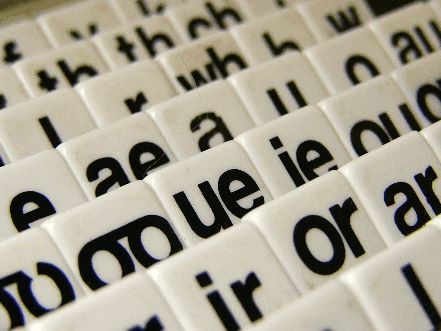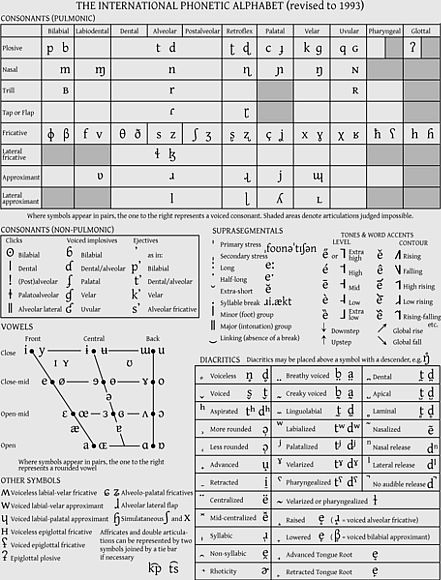How Do You Say It?
A look at sound notation systems

|
When you learn another language, everything about it is new and fresh. You need to learn an entirely different set of words for everything there is. The grammar is foreign, literally, and even the writing system might pose a challenge. But perhaps the strangest issue you will encounter is the sound of the language. A language is composed of a series of sounds, called phonemes, represented by the letter and letter groupings in the words.  Man forming his mouth to produce a wide, protruded vowel We learn these for our own language when we learn how to pronounce our alphabet, and we also recognize how these sounds change in certain situations. For example, in English, the sound of a vowel in a word can change if the letter "e" is added to the end, even if the "e" is not pronounced. The "a" in "can" is different from the "a" in "cane", simply because of the addition of a silent letter at the end. In Italian, the letter "h" (acca) is silent, but changes the way "c" is pronounced. The letter combination of "ci" is pronounced like the English "ch", but ironically, the combination of "chi" is like the English "k". Just learning the way the new writing system sounds (and I say "writing system" because, strictly speaking, not all languages use an alphabet. They might be syllabaries or pictographs instead) may not be the only hurdle. Depending on how different the new language is from your own, you may encounter some sounds that you have never heard or even be immediately capable of producing at the moment. There are far more sounds in languages than you will know in your native language, as odd as that may seem at first. For example, if your native language is English, then you will be very familiar with the sound of "th", which is done by pressing the tip of your tongue to the bottom of your top teeth and exhaling slightly with a slight hum. However, for an Italian, this a completely foreign sound, as there is no "th" combination pronounced like that in Italian. And by way of reversal, Italian (as well as a few other Italic languages) has a rolled "r", which can be difficult for a native English speaker to produce properly. These different sounds can be learned, of course, but it will take a lot of practice. The question is how do you learn to pronounce sounds you have never known before? Listening  Tiles of different letter pairs which form unique sounds The obvious first answer to this is by listening to native speakers. The more you hear the language spoken, either directly or through media like film and recordings, your ear will become atttuned to the sound. You can then begin to form the sound on your own, comparing it to what you hear. Audio courses like Pimsleur can be very useful for this. Working with another person will be the most useful, because they will be able to correct your pronunciation and pick up on the nuances you are not yet capable of hearing. This can be done in a language class, with a tutor, with someone on Skype, or with a friend. A newer approach to this, in the age of the internet, is using a recording system on a website which allows you to record yourself reading a text in the new language, then having others give you feedback, either written or by way of another recording. I think this method is the most versatile, since it is both interactive but also asynchronous - the person helping you does not need to be online at the same time as you. You can also potentially get responses from a larger group of people. Reading Unfortunately, it is not always possible to practice with another person, or to use audio materials. This may be because the language is not widely spoken, you are unable to find someone willing to talk with you, or you simpleydo not have access to the resources that allow interaction or even listening to recorded materials. If this is the case, then you will have to rely upon a book to teach you how to speak. Is that really possible? Well, you will always need to talk to a live person to truly refine your pronunciation, but a book is capable of explaining the basic sounds, so you can begin to speak the words properly. Any written material trying to describe sounds will need to have some kind of standardized system so that it can be applied to many languages and be understood in the same way by other learners. IPA  IPA chart, as revised in 1993 The first and most important sound notation system is the International Phonetic Alphabet, or simply IPA. It uses symbols based upon the Latin alphabet to depict sounds. That is, while the Latin alphabet can be used to represent most of the sounds in English, the IPA uses it, along with many other symbols and variants, to represent all of those sounds as well as those in other languages. The IPA was devised by the International Phonetic Association and they occasionally revise it by adding, removing, or modifying letters and diacritics. Currently, there are around 107 "letters" and 52 diacritics (marks that can be added to a letter to further define the sound). It was first created by a group of British and French language teachers in 1886. French linguist Paul Passy led the initial creation of the alphabet, but the idea was proposed to him in a letter by Danish linguist Otto Jesperson. It started out as a spelling reform for English, but was expanded to make it usable for other languages. At first, the sounds represented by the letters could vary between the languages, but in 1888, it was revised so that the letter to sound representation was uniform for everyone. But how does it actually represent sounds? In linguistics, the study of language sounds is called "phonology", and through that, the methods that the human mouth and nose produce sounds have been given specific terms. For example, there is a term "fricative", which can be defined as "consonants produced by forcing air through a narrow channel made by placing two articulators close together". An "articulator" is "the point of contact where an obstruction occurs in the vocal tract between an articulatory gesture, an active articulator, and a passive location". Other equally complex terms include labial, bidental, dorsal, radical, glottal, sonarant, lateral, pulmonic, alveolopalatal, uvular, pharyngeal, and affricative. Some of these are probably harder to pronounce than the sounds they refer to. To a linguist who has studied these terms and understands how thy apply to the mouth and nose, the IPA should provide an easy path to pronunciation. Perhaps you have learned them yourself, and are quite knowledgable about how the IPA works. To others, such as myself, however, it is a very daunting system to learn. If I want to learn how to pronounce an "m", do I really need to understand what "bilabial nasal" (or is it "nasal bilabial") means? Just the thought of a sound defined as "aveolopalatal lateral approximant" makes me want to cringe and look away. This is one the reasons that despite its purpose to make it easier for people to learn pronunciations, it is still only commonly used in academic work. Not even all dictionaries use it.  Entries in dictionary which use IPA to denote pronunciation Another problem, and not specially with the IPA, is that despite being standardized, it is hard to get people to agree on how a sound should be represented. I learned this when I was creating a new design for products. I wanted to show the letters “IPA” written in IPA. So I found what I thought was the proper way, then asked a group of people to verify (I did not want to put a design that was wrong on products I was selling). What I got was a long debate involving a dozen people, arguing over the proper way it should be done. I was very surprised, since I was fooled by the idea of it being "standardized". The problem is not with the standardization but rather with how different people hear and speak sounds. Think of it this way: if I ask five people to look at a painting, then tell me what it means to them, I am likely to get five different responses, because each person is seeing it with the biased of their own ideas and feelings, which are unique from everyone else. Similarly, our brains and ears are trained differently, depending upon what languages and sounds we have heard and used during our lives. Some people will understand a sound in one way, but another person, while hearing the same overall sound, will hear slight variants. Perhaps they hear a more defined palatization or the trace of a trill. In that case, they will want to represent it differently from each other, while a person who is new to all of it will not hear a difference. This can happen between two people that have the same native language. Now imagine what it is like between two people with different languages, trying to define the sounds of a third? |
| How Do You Say It? - A look at sound notation systems | |||||||||
| Writer: | Erik Zidowecki | ||||||||
| Images: | |||||||||
| |||||||||
All images are Copyright - CC BY-SA (Creative Commons Share Alike) by their respective owners, except for Petey, which is Public Domain (PD) or unless otherwise noted.
comments powered by Disqus
















